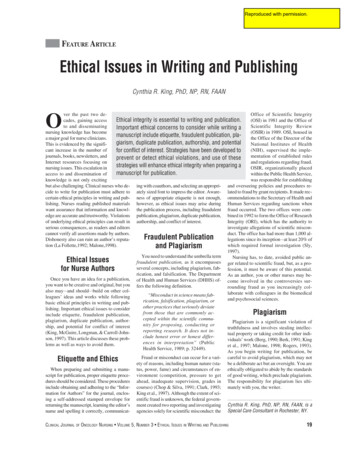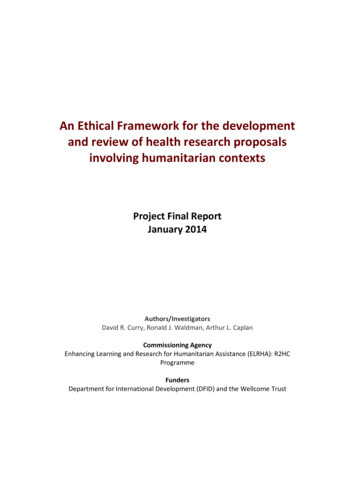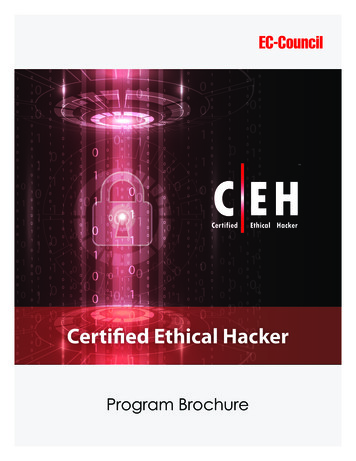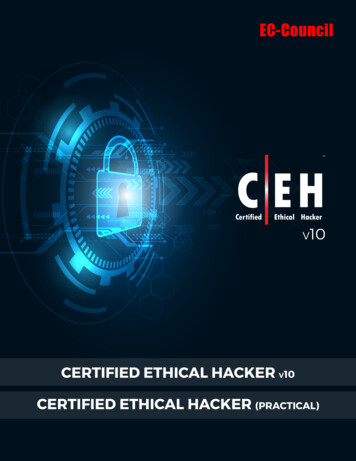
Transcription
Reproduced with permission.FEATURE ARTICLEEthical Issues in Writing and PublishingCynthia R. King, PhD, NP, RN, FAANver the past two deOffice of Scientific IntegrityEthical integrity is essential to writing and publication.cades, gaining access(OSI) in 1981 and the Office ofto and disseminatingScientific Integrity ReviewImportant ethical concerns to consider while writing anursing knowledge has become(OSIR) in 1989. OSI, housed inmanuscript include etiquette, fraudulent publication, plaa major goal for nurse clinicians.the Office of the Director of thegiarism, duplicate publication, authorship, and potentialThis is evidenced by the signifiNational Institutes of Healthcant increase in the number of(NIH), supervised the implefor conflict of interest. Strategies have been developed tojournals, books, newsletters, andmentation of established rulesprevent or detect ethical violations, and use of theseInternet resources focusing onand regulations regarding fraud.strategies will enhance ethical integrity when preparing anursing issues. This escalation inOSIR, organizationally placedmanuscript for publication.access to and dissemination ofwithin the Public Health Service,knowledge is not only excitingwas responsible for establishingbut also challenging. Clinical nurses who de- ing with coauthors, and selecting an appropri- and overseeing policies and procedures recide to write for publication must adhere to ately sized font to impress the editor. Aware- lated to fraud by grant recipients. It made reccertain ethical principles in writing and pub- ness of appropriate etiquette is not enough, ommendations to the Secretary of Health andlishing. Nurses reading published materials however, as ethical issues may arise during Human Services regarding sanctions whenwant assurance that information and knowl- the publication process, including fraudulent fraud occurred. The two offices were comedge are accurate and trustworthy. Violations publication, plagiarism, duplicate publication, bined in 1992 to form the Office of Researchof underlying ethical principles can result in authorship, and conflict of interest.Integrity (ORI), which has the authority toserious consequences, as readers and editorsinvestigate allegations of scientific misconcannot verify all assertions made by authors.duct. The office has had more than 1,000 alFraudulent PublicationDishonesty also can ruin an author’s reputalegations since its inception—at least 20% ofwhich required formal investigation (Sly,tion (La Follette,1992; Malone,1998).and Plagiarism1997).You need to understand the umbrella termNursing has, to date, avoided public anEthical Issuesfraudulent publication, as it encompasses ger related to scientific fraud, but, as a proseveral concepts, including plagiarism, fab- fession, it must be aware of this potential.for Nurse Authorsrication, and falsification. The Department As an author, you or other nurses may beOnce you have an idea for a publication, of Health and Human Services (DHHS) of- come involved in the controversies suryou want to be creative and original, but you fers the following definition.rounding fraud as you increasingly colalso may—and should—build on other collaborate with colleagues in the biomedical“Misconductinsciencemeansfableagues’ ideas and works while followingand psychosocial sciences.rication, falsification, plagiarism, orbasic ethical principles in writing and pubother practices that seriously deviatelishing. Important ethical issues to considerfrom those that are commonly acPlagiarisminclude etiquette, fraudulent publication,cepted within the scientific commuplagiarism, duplicate publication, authorPlagiarism is a significant violation ofnity for proposing, conducting orship, and potential for conflict of interesttruthfulness and involves stealing intellecreporting research. It does not in(King, McGuire, Longman, & Carroll-Johntual property or taking credit for other indiclude honest error or honest differson, 1997). This article discusses these probviduals’ work (Berg, 1990; Berk, 1991; Kingences in interpretation” (Publiclems as well as ways to avoid them.et al., 1997; Malone, 1998; Rogers, 1993).Health Service, 1989; p. 32449).As you begin writing for publication, becareful to avoid plagiarism, which may notFraudormisconductcanoccurforavariEtiquette and Ethicsety of reasons, including human nature (sta- be a deliberate act but an oversight. You areWhen preparing and submitting a manu- tus, power, fame) and circumstances of en- ethically obligated to abide by the standardsscript for publication, proper etiquette proce- vironment (competition, pressure to get of good writing, which preclude plagiarism.dures should be considered. These procedures ahead, inadequate supervision, grades in The responsibility for plagiarism lies ultiinclude obtaining and adhering to the “Infor- courses) (Chop & Silva, 1991; Clark, 1993; mately with you, the writer.mation for Authors” for the journal, enclos- King et al., 1997). Although the extent of sciing a self-addressed stamped envelope for entific fraud is unknown, the federal governreturning the manuscript, learning the editor’s ment created two reporting and investigating Cynthia R. King, PhD, NP, RN, FAAN, is aname and spelling it correctly, communicat- agencies solely for scientific misconduct: the Special Care Consultant in Rochester, NY.OCLINICAL JOURNAL OF ONCOLOGY NURSING VOLUME 5, NUMBER 3 ETHICAL ISSUES IN WRITING AND PUBLISHING19
Although no definitive answers exist, thequestion of whether self-plagiarism occursis an issue. Some authors have written several chapters for several different books thatare changed only slightly. Each manuscriptis copyrighted when published. Becauseyou, as the author, no longer own the rightsto these words, you should not plagiarizethem. Most editors and reviewers would argue that self-plagiarism is unethical. Thus,you cannot copy your own material for a newmanuscript without permission. You can,however, copy your material if you own thecopyright. Alternatives include using quotesaround short phrases of your own work andciting appropriate references (Blancett,1993; King et al., 1997). If you are new towriting and publishing, you may wish toseek advice from expert authors, facultymembers, or editors or refer to recommendations to avoid plagiarism (Rogers, 1993)(see Figure 1).Other questions related to plagiarism include the following. Should all levels of plagiarism, rangingfrom paraphrasing without any citation tocopying verbatim, be treated the same? What due process is needed to validateplagiarism? Should the intentional plagiarist be treateddifferently than the unintentional plagiarist? Is a poster considered a published workthat then is written up in an article?In regard to the last question, the editorsof the New England Journal of Medicinehave taken the position that posters areequivalent to abstracts, thus, they can be displayed without jeopardizing a manuscript.Each journal, however, should develop a policy related to poster presentation and subsequent publishing.Rogers (1993) provided numerous recommendations for avoiding plagiarism (see Figure 1), ranging from using quotation marksaround material taken verbatim from a Use quotation marks around words taken verbatim from a source. Change no part of a quotation within the context of the sentence. Use single marks for a quotation within a quotation. Use ellipses (a space and three periods) for apart of the quotation omitted. Use brackets around added words. Limit the use of direct quotes. Attempt to paraphrase the information, orsummarize the information derived from a variety of sources using one’s own words.FIGURE 1. RECOMMENDATIONS TO AVOIDPLAGIARISMNote. Based on information from Rogers, 1993.20CriteriaIdentical contentHighly similar articles with minimal modificationsSeveral articles when one would be enoughSequential articles about the development of workSimilar articles for various disciplinesRamificationsConsumption of resources (space in journal and editor/reviewer time)Inundation of the system with already published ideas rather than new materialEncouragement of the publish-or-perish phenomenonPotential of professional liability for the authorPossible violation of copyright when the author publishes duplicate informationInflation of the importance of a topic/studyReward for less productive authors who may overload the literatureFIGURE 2. CRITERIA FOR DUPLICATE PUBLICATIONS AND THEIR RAMIFICATIONSNote. Based on information from Blancett, 1991; Blancett et al., 1995; Smith et al., 1991; Yarbro, 1995.source to attempting to summarize the information. These recommendations are especially helpful for novice writers.Duplicate PublicationAlso known as redundant publication, duplicate publication involves publishing thesame material, in the same format, in morethan one journal, book, or Internet resource(King et al., 1997; Malone, 1998; Sly, 1997).Some editors are developing policies in an effort to prevent duplicate publication. As editor of the New England Journal of Medicine,Ingelfinger developed a policy that allows amanuscript to be published only if it has notbeen submitted somewhere else (Angell &Kassirer, 1991; King et al.).The practice of single submission (onesubmission of one manuscript to one journalat a time and no resubmission to anotherjournal until a written rejection has been received) is essential to protect the writer andpublisher. Editors must have exclusive rightsto the manuscript (Copp, 1993). The principle of single submission does not eliminate consideration for publication of anypaper previously rejected by another journal. The primary responsibility for preventing duplicate publication remains with theauthor. You should inform editors of anypotential duplicate publications.The question of how many articles couldor should be generated from a project is unanswerable. Figure 2 lists criteria for determining when material may be considered“duplicate.”The number of authors who deliberatelypublish duplicate papers is unknown. One article described a 12% duplicate publishing rateover four years (Boots et al., 1992), whereasBlancett, Flanagin, and Young (1995) discovered a 28% duplicate publishing rate. Multiple ramifications result from duplicatesubmissions and publications, ranging fromconsumption of valuable resources (e.g., journal space, editorial and reviewer time) to further encouraging the “publish or perish”phenomenon (Angell & Relman, 1989;Bishop, 1984; Blancett et al.; Yarbro, 1995)(see Figure 2).Occasionally, editors will agree to duplicate publications under certain conditions, including agreement by editors of both journals,a second version that accurately reflects theprimary article, or a footnote in the secondpaper informing the reader of the primary article (Blancett, 1991). The literature providesnumerous recommendations for authors andeditors to help prevent duplicate publication(see Figure 3). These recommendations maybe helpful to clinicians who are new authorsor when the question of submission of multiple articles on a single project arises.If you are a novice author, you may notbe sure what determines whether material isconsidered “duplicate.” Think about thequestions presented in Figure 4 to determineif material may be redundant.Authorship IssuesAuthorship issues consistently surface innursing and other professions. Even if youare experienced with the publication process,you are likely to have observed such situations with colleagues or acquaintances. Issues tend to arise when writing a manuscriptwith multiple authors. Authorship disagreements can lead to embarrassment, anger, animosity, bitterness, wrecked friendships, anddestruction of professional relationships and,ultimately, can damage careers. You mustassume some responsibility for accuracy ofyour written material, but how much responsibility is reasonable (Baird, 1984; De Tornyay, 1984; King et al., 1997; Klein &Moser-Veillon, 1999; Sly, 1997)?The following is one definition regardingauthorship that frequently is endorsed.SUPPLEMENT TO MAY/JUNE 2001 VOLUME 5, NUMBER 3 CLINICAL JOURNAL OF ONCOLOGY NURSING
Recommendations for Authors Obtain the “Information for Authors” from the journal. Read the journal’s policies carefully. Talk to the editor of the journal regarding proposed manuscript if a concern about possible duplication exists.Recommendations for Editors Spell out the journal’s concept of duplicate publishing and opposition to this practice. Request that the author send copies of related materials previously published. Remind authors of the journal’s policies on submission. Attend scientific meetings to share the journal’s policies with potential authors. Use peer review.FIGURE 3. RECOMMENDATIONS FOR THE PREVENTION OF DUPLICATE PUBLICATIONNote. Based on information from Yarbro, 1995.“All persons designated as authorsshould qualify for authorship. Each author should have participated sufficiently in the work to take public responsibility for it. Authorship creditshould be based only on substantialcontributions to: a) conception and design, or analysis and interpretation ofdata; b) drafting the article or revisingit critically for important intellectualcontent; and on c) final approval of theversion to be published. Conditions (a),(b), and (c) must all be met.” (International Committee of Medical JournalEditors [ICMJE], 1988, p. 259).In addition to all authors needing to takeresponsibility for a published manuscript, noone who is responsible for a part of an articleshould be omitted from authorship. Thus, determining the appropriate number of authorsis difficult (Klein & Moser-Veillon, 1999).Inclusion of many individuals as authors ofpapers resulting from multicenter trials is common and should be a concern for nurses in specialties such as oncology (Klein & MoserVeillon, 1999). Most definitions include thecriterion that authors should have made “sufficient contributions” to be able to take responsibility for the manuscript (Kassirer & Angell,1991). Thus, a clinician or research assistantwho only contributed by enrolling patients ina study should not be listed as an author.A related concept to authorship isacknowledgement. People who provide finan- Is this content identical to something previously published? Is this similar to other materials with onlyminimal changes? Have I written several publications when onewould be enough? Have I written very similar publications formore than one discipline?FIGURE 4. QUESTIONS TO ASK REGARDINGPOTENTIAL DUPLICATE PUBLICATIONcial assistance and technical support or werecommittee members should be acknowledgedbut not recognized as authors (Klein &Moser-Veillon, 1999). Examples of specificcontributions that might warrant acknowledgement include sources of funding, provision of expert technical assistance, review andcritique of a manuscript, assistance with statistical analysis and interpretation, or participation in the formulation of ideas or planningof a project. Even acknowledgments are becoming a problem as manuscripts increase inlength and detail (Kassirer & Angell, 1991).Be careful not to acknowledge individualswhose contribution is within their normal jobresponsibilities (King et al., 1997).Some journals have begun to limit thenumber of authors listed in the reference tofour or six (e.g., New England Journal ofMedicine, Lancet). Others suggest that authorship should only appear as a footnote onthe title page with each author’s contribution (Sly, 1997).Potential Causes of AuthorshipIssuesUnless you are an individual who likes towrite alone, you are likely to become a partof a team of authors at some time (Fain,1997). Two common reasons authorshipproblems arise are failure to reach agreementat the beginning of the project and discussions that are vague and undocumented. Another reason relates to the contribution ofauthors either to the paper itself or to the entire project over time. If you are a novicewriter, you may make assumptions aboutwhether you deserve authorship. As a result,you may be either omitted or be includedwhen you did not meet the authorship criteria. You also may feel that inclusion of wellknown or well-connected people mayenhance the credibility of your work or increase the chances of publication. You alsomay feel that you should include facultymembers who mentored you. Finally, in along-term project, your or other authors’level of activity or contributions maychange. Authors may drop out temporarilyor permanently, their efforts may wax andwane, and new people may join the project.Thus, it may be helpful for you to ask thefollowing questions (Baird, 1984; Brooten,1986; Carpenito, 1993; Fye, 1990; Gay, Lavender, & McCard, 1987; King et al., 1997;Klein & Moser-Veillon, 1999; Stevens,1986; Waltz, Nelson, & Chambers, 1985). Who should be an author? What constitutes authorship? When should authorship be decided? How should coauthorship be implemented? What are the rights and responsibilities ofcoauthors? When is the use of acknowledgement appropriate? How do publication practices of other disciplines influence nurses? What if contributions to a project changeover time or participants do not meet theirobligations?Potential Solutions toAuthorship IssuesTo avoid authorship problems, some journals are promoting responsibility by creatinguniform requirements; however, these may beoverly restrictive. Editors and authors needto work together to develop appropriateguidelines (Klein & Moser-Veillon, 1999).King and colleagues (1997) suggested fivekey areas of activity that will help to preventor resolve almost any authorship issue (seeFigure 5). They are (a) initial and ongoingcommunication among authors, (b) identification of authors’ individual needs,preferences, and goals, (c) use of establishedauthorship guidelines, (d) use of a systematicprocess of determining and implementing authorship, and (e) editorial intervention whennecessary.The most significant solution recommended is communication, which should occur both initially and throughout the project.Specifically, you, as an author, must discussauthorship as the project is beginning. Youshould reach agreement on authorship andacknowledgements and put decisions in writing. Throughout the project, you should revisit these agreements and communicateprogress on all phases of publication to otherauthors (Fain, 1997; King et al., 1997; Malone, 1998).When involved in a group activity, determining authorship and identifying eachindividual’s personal and professional needs,preferences, and goals related to publicationCLINICAL JOURNAL OF ONCOLOGY NURSING VOLUME 5, NUMBER 3 ETHICAL ISSUES IN WRITING AND PUBLISHING21
are important. For example, you may want tobe first author to help with promotion; someone else simply may want the opportunity toparticipate (Brooten, 1986; King et al., 1997).The best strategy to determine such needs isto conduct a group meeting of all involved inthe project and ask them to come prepared toshare their personal goals. The discussionshould be facilitated effectively so that eachmember can comfortably discuss what he orshe wants. These desires then can be used toformulate the group’s plans for disseminationof the project’s outcomes.In addition to determining individualgoals, referring to the formal criteria orguidelines for authorship can be helpful(ICMJE, 1988; Klein & Moser-Veillon,1999; Nativio, 1993). Using a specific set oforganizational guidelines, position statements, institutional policies, journal requirements, or literature-based recommendationson authorship can provide guidance for specific issues such as who should be authorsand what their contributions should be.A systematic decision-making process ofauthorship is another effective technique thatshould be started at the beginning of theproject. This involves communication, aswell as involving more of a process forreaching agreements on various issues (seeFigure 5), documenting them, and periodically revisiting them.The last potential activity is editorial intervention. This should be used as a last resort to help resolve authorship issues.Occasionally, the communication processCommunication Hold discussions at the beginning of project. Reach agreement on authorship andacknowledgement. Revisit decisions throughout the project. Communicate progress on manuscripts. Inform colleagues of submissions and outcomes. Reach agreement on revised submissions.Identification of Individual Needs Identify personal and professional needs,preferences, and goals. Use information to make publication plans. Use established authorship criteria.Use of Systematic Process Hold discussions early. Agree on number of papers, authors, and author order, and have back-up plans if peopledo not meet obligations, submission plans,and arbitration mechanisms. Document everything in writing. Revisit the agreements periodically.Editorial InterventionFIGURE 5. POTENTIAL SOLUTIONS TOAUTHORSHIP ISSUES22fails, a group reaches a stalemate, or differences between authors appear irreconcilable.The group may seek counsel from the editorof the journal in which it wishes to publishthe manuscript. An editor will listen to theissues, help identify viable options, and assist authors in reaching a mutually agreeablesolution that remains commensurate withjournal publication policies. This solutioncan be very helpful in providing objectivityand resolving tense situations.Potential Conflictof InterestConflict of interest arises when personalinterests are compromised or have the appearance of compromising your ability to carry outprofessional duties objectively (Biaggioni,1993). Attention to intellectual and financialconflicts of interest has prompted professionalorganizations and editors of professional journals to institute and periodically review policies and procedures to ensure that disclosureis required of potential presenters and authors.Organizations have prepared guidelines toassist investigators, universities, and other institutions to deal with actual or potential conflicts of interest. The American Federation forClinical Research and the Association ofAmerican Medical Colleges have establishedguidelines regarding public disclosure of information. The American Medical Association and the Pharmaceutical Manufacturer’sAssociation have proposed guidelines regarding ethical support from pharmaceutical companies. Professional organizations, includingthe Oncology Nursing Society, have developed disclosure policies. Before publishing anarticle, the author may benefit from reviewing and discussing potential conflict of interest issues. You, as an author, must check withyour institution and publisher/editor to determine the current policies and guidelines.Intellectual Conflictof InterestA definition of intellectual conflict of interest includes situations in which generalknowledge may contradict what is reported.For example, most authors cite references supporting their work, but some may either incorrectly cite the references or the referencesdo not adequately support their point. Whenauthors submit a manuscript, they are askedto follow guidelines of the journal. To helpprevent intellectual conflict of interest, authorsare asked to indicate to the editor whether theyhave published the same or a substantiallysimilar manuscript in another book or journal(Blancett, 1993).Controversies may arise related to the useof instruments that are developed and testedby others without giving them proper credit.The location of appropriate acknowledgementin the manuscript also is a concern. If you seekand obtain it, you are obligated to transmitthe results to the original developer. Reviewing copyright law, style manuals, and publishers’ copyright transfer forms may benecessary (Blancett, 1993).Carpenito (1993) offered recommendations for students, clinical nurses, faculty,deans and chairs, managers and consultants,and editors (see Figure 6). The challenge fornursing is maintaining both personal and collective professional integrity.Financial Conflict of InterestFinancial conflict of interest surfaces whena financial association exists between theauthor(s) and a commercial company. Forexample, authors may have received consistent financial support from a journal or drugcompany for their work and its results. Insome instances, studies may not have beenpossible without this financial support. Although investigators in most instances acknowledge support, the question of theintegrity of the results remains. Individualswho receive such support should be carefulthat their actions not be seen as promoting aparticular product. Financial disclosure is required of authors when submitting manuscripts to most professional journals. Thispolicy protects individuals from any kind ofsuspicion. Guidelines related to financial conflict of interest are displayed in Figure 7.No right or wrong answers exist to questions of conflict of interest. Case studies areused frequently in seminars and classes onwriting and publishing to facilitate discussionof this topic. Conflict of interest should continue to be discussed, and policies and guidelines should be developed and followedclosely to safeguard the scientific integrity ofnursing. Clinical nurses may be less aware ofpotential conflicts of interest, policies, andguidelines. You, as an author, must ask colleagues, reviewers, and editors to help youdetermine if you have a conflict of interest. Formulate a plan to deal with authorship issues. Discuss criteria for coauthorship. Prepare guidelines or policies about potentialconflict of interest. Acknowledge assistance from institutions,employer, and companies.FIGURE 6. STRATEGIES FOR NURSES TO AVOIDCONFLICT OF INTERESTNote. Based on information from Carpenito, 1993.SUPPLEMENT TO MAY/JUNE 2001 VOLUME 5, NUMBER 3 CLINICAL JOURNAL OF ONCOLOGY NURSING
Acknowledge all research support. State any financial relationship betweenauthor(s) and commercial or educationalproducts. Describe affiliations with direct interest in thesubject manner (e.g., employment, stockownership, consultancies, honoraria). Adhere to “Information for Authors” guidelines.FIGURE 7. GUIDELINES FOR DISCLOSURE OFACTUAL/POTENTIAL CONFLICT OF INTEREST FORAUTHORSConclusionAs nurses, we need to maintain high standards of scholarly work and stress the importance of integrity in the dissemination ofknowledge. Scholarly work must be conducted responsibly and ethically. It may behelpful to keep in mind what Fulghum(1989) taught us about kindergarten, “Don’ttake things that aren’t yours,” “play fairly,”and “share everything.” These are importantprinciples for authors to remember.ReferencesAngell, M., & Kassirer, J. (1991). The Ingelfingerrule revisited. New England Journal of Medicine, 325, 1371–1373.Angell, M., & Relman, A.S. (1989). Redundantpublication. New England Journal of Medicine, 320, 1212–1214.Association of American Medical Colleges.(1990). Guidelines for dealing with facultyconflicts of commitment and conflicts of interest in research. Academy of Medicine, 65, 488–496.Baird, S.B. (1984). Messes we make for ourselves[Editorial]. Oncology Nursing Forum, 11(4), 9.Berg, A.O. (1990). Misconduct in science: Doesfamily medicine have a problem? FamilyMedicine, 22(2), 137–142.Berk, R.N. (1991). Is plagiarism ever insignificant? American Journal of Roentgenology,157, 614.Biaggioni, I. (1993). Conflict of interest guidelines: An argument for disclosure. Pharmacyand Therapeutics, 322, 324.Bishop, C. (1984). How to edit a scientific journal. Philadelphia: ISI Press.Blancett, S.S. (1991). Redundant publication:When is enough enough? Nurse Educator,16(3), 3.Blancett, S.S. (1993). Who is entitled to authorship? [Editorial]. Journal of Nursing Administration, 23(1), 3.Blancett, S.S., Flanagin, A., & Young, R.L.(1995). Duplicate publication in the nursingliterature. Image: Journal of Nursing Scholarship, 27(1), 51–56.Boots, S., Burns, D.E., Knoll, E., Squires, B.,Woolf, P., Yankauer, A., & Kelin, K.P. (1992).Redundant publication: What is it and what canbe done about it? CBE Views, 15(6), 123–124.Brooten, D.A. (1986). Who’s on first? [Editorial].Nursing Research, 35, 259.Carpenito, L.J. (1993). Loose authorship [Editorial]. Nursing Forum, 28, 3.Chop, R.M., & Silva, M.C. (1991). Scientificfraud: Definitions, policies, and implications innursing research. Journal of Professional Nursing, 7, 166–171.Clark, A.J. (1993). Responsible dissemination ofscholarly work. Journal of Neuroscience Nursing, 25, 113–117.Copp, L.A. (1993). Ethics and scholarly writing.Journal of Professional Nursing, 9, 67–68.De Tornyay, R. (1984). Who should be author?[Editorial]. Journal of Nursing Education23(1), 7.Fain, J.A. (1997). Maintaining scientific integrityin publications [Editorial]. Diabetes Educator,23(3), 232.Fulghum, R. (1989). All I really need to know Ilearned in kindergarten. New York: VillardBooks.Fye, W.B. (1990). Medical authorship: Traditions,trends, and tribulations. Annals of InternalMedicine, 113, 317–325.Gay, J.T., Lavender, M.G., & McCard, N. (1987).Nurse educator views of assignment of authorship credits. Image: Journal of Nursing Scholarship 19, 134–137.International Committee of Medical Journal Editors. (1988). Uniform requirements for manuscripts submitted to biomedical journals.Annals of Internal Medicine, 108, 258–265.Kassirer, J.P., & Angell, M. (1991). On authorship and acknowledgements. New EnglandJournal of Medicine, 325, 1510–1512.King, C.R., McGuire, D.B., Longman, A.J., &Carroll-Johnson, R.M. (1997). Peer review,authorship, ethics, and conflict of interest. Image: Journal of Nursing Scholarship, 29, 163–167.Klein, A., & Moser-Veillon, P.B. (1999). Authorship: Can you claim a byline? Journal ofAmerican Dietic Association, 99(1), 77–79.La Follette, M. (1992). Stealing into print: Fraud,plagiarism, and misconduct in scientific publishing. Berkeley, CA: University of Cal
tion (La Follette,1992; Malone,1998). Ethical Issues for Nurse Authors Once you have an idea for a publication, you want to be creative and original, but you also may—and should—build on other col-leagues' ideas and works while following basic ethical principles in writing and pub-lishing. Important ethical issues to consider










